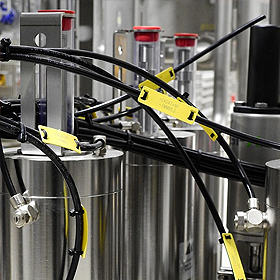
What factors affect gasket performance when that product is utilized in a high-pressure vessel? Think about it for a moment. Imagine a horizontally oriented storage unit and the seals that secure a discharge port or an access hatch. What’s the first thing we notice when these rounded ports come into view? It’s the encircling ring of bolted fasteners, a feature that somehow influences the maximum variable pressure threshold of the gaskets.
Explaining Pressure Variability
Constants are welcome elements in any engineering discipline. They’re nice and easy to predict. Unfortunately, there are typically score of variables in motion at any given moment when a real-world engineering event is underway. Furthermore, if the engineered systems are responsible for a fluid, then the variable number swells as strange dynamic forces have their way. In high-pressure vessel design, rolled sheet metal panels and welded seams contain those dynamic forces, with a series of auxiliary fittings and pipes also channeling the fluid load when the liquid is moved elsewhere. Gaskets are the glue that hold the access plates and flange connectors securely in place on and around the storage vessel. How, then, do these seals react to the pressure variables we’ve briefly summarized so far?
Maximum Variable Pressure Ratings and Gasket Behaviour
As described earlier, one of the more immediate performance factors is identified on sight. It’s the mechanically applied torque, the pressure applied on the gasket material by the ring of fasteners. That steely band of bolts is perceived as a bolt load versus gasket load issue, a relationship that alters the elastic properties of the seal. Dependent on bolt torque, the stress placed on the port seal material will also plastically deform the gasket and produce a subsequent shift in the gasket’s spring index. Do these hampered performance features mean danger is in the air? Yes, to be absolutely blunt, the material changes will create an opportunity for a sealing defect. Picture a pressure increase. The gasket compresses, which it should, but if its maximum variable pressure rating isn’t satisfactory, then its compromised plasticity attribute will stop the seal from ‘springing’ back after the loading event has passed.
Leakage occurs if the gasket can’t vary its shape to accommodate this maximum variable pressure feature, so the selected material must be elastically and plastically designed to ensure full dimensional expansion after the fluid loading event has elapsed. By design, there are engineering equations that establish a required mutability feature within the sealing material. They add fastener load, material type, fluid pressure characteristics, and other pressure vessel-related criteria to complex formulas so that the seal always performs at its adaptable best.

How does the term ‘High-Pressure Vessel’ impact gasket design? For openers, this is an engineering scenario that implies a substantial stress factor. The pressure, if it were to be released, would be dangerously high, perhaps even explosively destructive. If that pressurized fluid is to be reliably contained at each and every vessel seam, capable gasket materials must be employed then correctly installed. What exactly are the best materials for this job?
Choose Metallic Strength
Strong elastomers equipped with a fluoropolymer backbone compress and then hold their shape when the upper end of the medium pressure scale is realized. Equally resilient carbon seals and mineral fibre inserts provide adequate jointing properties when they’re moderately stressed, plus they retain their strength when the fluid temperature climbs high. For true high-pressure resistance, however, it’s metal that gets the recruitment call. Pure metal rings, alloy gaskets with graphite inserts, and even specially profiled ceramic-packed rings fill this gasketing family with metallurgically established durability. Let’s check out those solid metal gasket materials.
A Stronger Gasket: Alloys and Pure Metals
Picture metal seals as the ultimate high-pressure sealing solution. Sure, at least initially, the alloys seem too rigid and too unyielding, but all metals include a certain degree of elasticity. That slight amount of malleability acts just like the compression feature inside an elastomeric seal, except the feature is far more capable as a stress mitigation mechanism. Obviously, softer alloys have a strong presence here, with bronze and copper providing a fluid-resistant base, especially when the conveyed fluids have a corrosive ingredient. Higher up on the pressure spectrum, its aluminium and stainless steel that provide more strength, yet these alloys still have a slight amount of elasticity locked inside their structural form so that they perform superbly in their gasketing duties. Again, these strong yet slightly material-soft alloys are designed to handle intense fluid pressures and just as severe temperatures.
What could be better than solid steel as a gasket material when the fluid pressure is transferring massive quantities of stress? In place of that dense ring of metal, there are specially profiled metal gaskets, products that handle blow-out stress and transient pressure spikes, among other things. They use corrugated layers and grooves to manipulate the compressible characteristics of the seal. Jacketed variants push that principle in a different direction by adding special fillers, including graphite to the mix. Finally, consider spiral wound gaskets, a semi-metallic solution that uses one or more V-shaped inserts to centre the ring and add resilience to gasket materials for high-pressure vessels.